Europe, British Isles, North-Central England, Staffordshire, Lichfield Cathedral [Map]
Lichfield Cathedral is in Lichfield, Staffordshire [Map].
Lichfield Cathedral [Map]. Exterior and General.
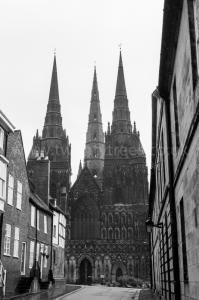
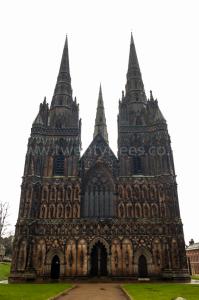
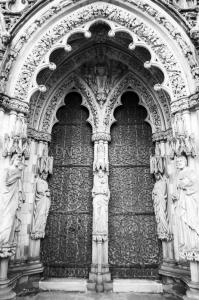
Lichfield Cathedral [Map]. Monument to the 80th Regiment of Foot sculpted by Peter Hollins.
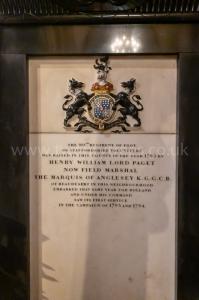
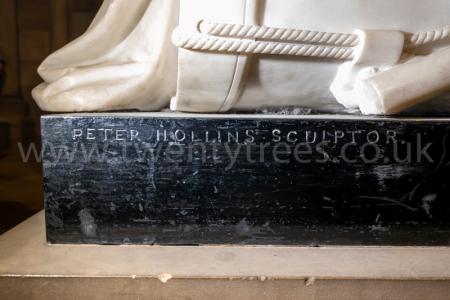
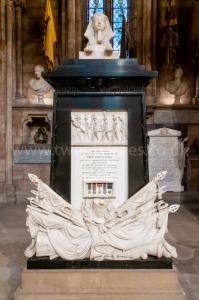
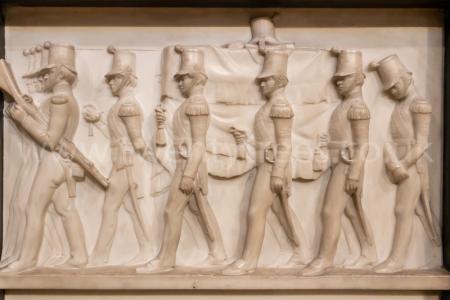
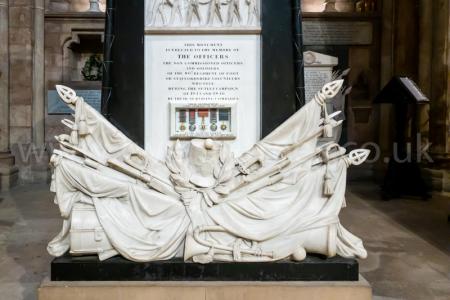
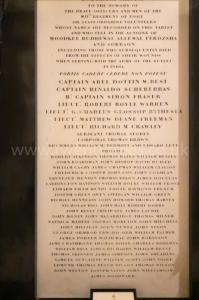
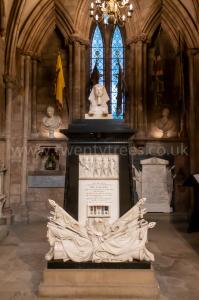
Lichfield Cathedral [Map]. General monuments.
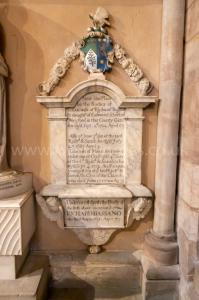
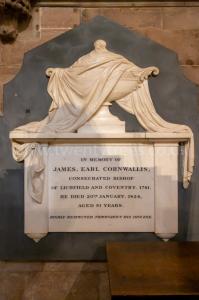
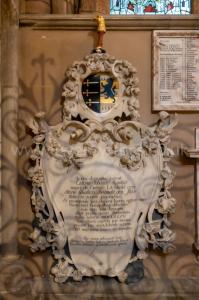
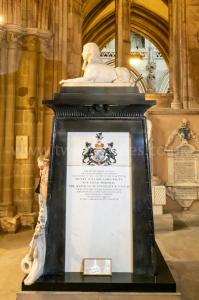
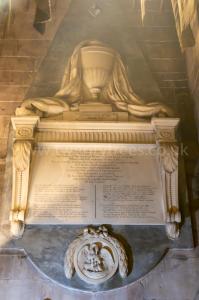
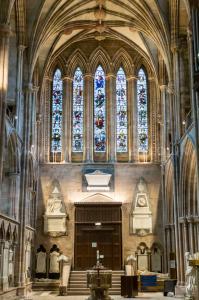
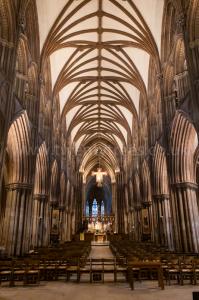
In 664 Bishop Chad of Mercia was elected Bishop of Lichfield.
After 672 Bishop Winfrith was elected Bishop of Lichfield.
On 02 Mar 672 Bishop Chad of Mercia died. He was buried at Lichfield Cathedral [Map].
Bede. 02 Mar 672. Ceadda died on the 2nd of March, and was first buried by St. Mary's Church [Map], but afterwards, when the church [Map] of the most holy prince of the apostles, Peter, was built, his bones were translated into it. In both which places, as a testimony of his virtue, frequent miraculous cures are wont to be wrought. And of late, a certain distracted person, who had been wandering about everywhere, arrived there in the evening, unknown or unregarded by the keepers of the place, and having rested there all the night, went out in his perfect senses the next morning, to the surprise and delight of all; thus showing that a cure had been performed on him through the goodness of God. The place of the sepulchre is a wooden monument, made like a little house, covered, having a hole in the wall, through which those that go thither for devotion usually put in their hand and take out some of the dust, which they put into water and give to sick cattle or men to drink, upon which they are presently eased of their infirmity, and restored to health. In his place, Theodore (age 70) ordained Winfrid, a good and modest man, to preside, as his predecessors had done, over the bishoprics of the Mercians, the Midland Angles, and the Lindisfarnes, of all which, Wulfhere (age 32), who was still living, was king. Winfrid was one of the clergy of the prelate he had succeeded, and had for a considerable time filled the office of deacon under him.
Bede. 674. Not long after, Theodore (age 72), the archbishop, taking offence at some disobedience of Winfrid, bishop of the Mercians, deposed him from his bishopric when he had his place. been possessed of it but a few years, and in his place made Sexwulf bishop, who was founder and abbot of the monastery of Medeshamstead, in the country of the Girvii. Winfrid, thus deposed, returned to his monastery of Barve [Note. Unknown location], and there ended his life in holy conversation.
In 716 Ceolred King Mercia died. He was buried at Lichfield Cathedral [Map]. His great uncle Eowa King Mercia succeeded King Mercia.
Anglo-Saxon Chronicle. 716. This year Osred (age 19), king of the Northumbrians, was slain near the southern borders. He reigned eleven winters after Ealdferth. Cenred then succeeded to the government, and held it two years; then Osric, who held it eleven years. This same year died Ceolred, king of the Mercians. His body lies at Lichfield [Map]; but that of Ethelred, the son of Penda, at Bardney [Map]. Ethelbald then succeeded to the kingdom of Mercia, and held it one and forty winters. Ethelbald was the son of Alwy, Alwy of Eawa, Eawa of Webba, whose genealogy is already written. The venerable Egbert (age 77) about this time converted the monks of Iona to the right faith, in the regulation of Easter, and the ecclesiastical tonsure.
Before 729 Bishop Aldwine was appointed Bishop of Lichfield and Bishop of Leicester.
In 779 Archbishop Hygeberht was elected Archbishop Lichfield.
In 779 Bishop Hygeberht was appointed Bishop of Lichfield.
Anglo-Saxon Chronicle. 785. This year died Bothwin, Abbot of Ripon, and a litigious synod was holden at Chalk-hythe; Archbishop Eanbert resigned some part of his bishopric, Hibbert was appointed bishop by King Offa, and Everth was consecrated king. In the meantime legates were sent from Rome to England by Pope Adrian, to renew the blessings of faith and peace which St. Gregory sent us by the mission of Bishop Augustine, and they were received with every mark of honour and respect.
In 958 a charter of King Edgar "Peaceful" I of England (age 15) describes Penkridge, Staffordshire [Map] as a "famous place". St Michael's Church Penkridge [Map] was established as a Royal Free Chapel making it a Royal Peculiar. The church was independent of the Bishop of Lichfield and, correspondingly, the Archbishop of Canterbury.
In or before 1026 Bishop Brihtmær was consecrated Bishop of Lichfield.
In 1039 Bishop Wulfsige was consecrated Bishop of Lichfield.
Anglo-Saxon Chronicle. 1053. About this time was the great wind, on the mass-night of St. Thomas; which did much harm everywhere. And all the midwinter also was much wind. It was this year resolved to slay Rees, the Welsh king's brother, because he did harm; and they brought his head to Gloucester on the eve of Twelfth-day. In this same year, before Allhallowmas, died Wulfsy, Bishop of Lichfield; and Godwin, Abbot of Winchcomb; and Aylward, Abbot of Glastonbury; all within one month. And Leofwine, Abbot of Coventry, took to the bishopric at Lichfield; Bishop Aldred to the abbacy at Winchcomb; and Aylnoth took to the abbacy at Glastonbury. The same year died Elfric, brother of Odda (age 60), at Deerhurst, Gloucestershire; and his body resteth at Pershore [Map].
John of Worcester. 1053. In the month of October died Wulfsige, bishop of Litchfield, Godwin (age 52), abbot of Winchcombe, and Ethelward, abbot of Glastonbury. Leofwine, abbot of Coventry, succeeded Wulfsige; and Ethelnoth, a monk of the same monastery, succeeded Ethelward. But Aldred, bishop of Worcester, kept the abbey of Winchcombe in his own hands until such tune as he appointed Godric, the son of Goodman, the king's chaplain, to be abbot. Ælfric, brother of earl Odda (age 60), died at Deerhurst on the eleventh of the calends of January [22nd December], but he was buried in the monastery at Pershore [Map].
Florence of Worcester Continuation. 07 Jan 1121. Meanwhile, two clerks were chosen to fill sees which had been vacant for some time; namely, Richard, who was keeper of the king's seal under the chancellor, and Robert, who had filled the office of steward of the meat and drink in the king's household with great industry. The first of these was preferred to the see of Hereford, the latter to the see of Chester [Note. Bishop of Coventry?]. Herbert, also, a monk of Westminster, was made abbot of that monastery.
Richard, chosen bishop of Hereford on Friday the seventh of the ides [the 7th] of January, was consecrated at Lambeth on Sunday the seventeenth of the calends of February [17th January] by Ralph, archbishop of Canterbury, with the assistance of Richard, bishop of London, and the bishops, Robert of Lincoln, Arnulph of Rochester, Urban of Glamorgan (age 45), and Bernard of St. David's.
Florence of Worcester Continuation. 13 Mar 1121. After this, the archbishop, having accompanied the king (age 53) to Abingdon [Map], consecrated on Sunday the third of the ides [the 13th] of March, Robert, before named, as bishop of Chester, there being present and assisting at this sacrament William, bishop of Winchester, William, bishop of Exeter, and the Welsh bishops, Urban (age 45) and Bernard.

Florence of Worcester Continuation. 12 Jun 1121. After a few days, one named Everard, attached to the king's chapel, was elected bishop of Norwich, and consecrated at Canterbury [Map] by archbishop Ralph on the second of the ides [the 12th] of June; Arnulph, bishop of Rochester, Richard, bishop of Hereford, and Robert, bishop of Coventry, having met for the purpose.
Florence of Worcester Continuation. 1127. A synod held at Westminster. William (age 57), archbishop of Canterbury, convened a general synod of all the bishops and abbots, and some men of religion from all parts of England, at the monastery of St. Peter, situated in the western part of London. At this synod he himself presided as archbishop of Canterbury and legate of the apostolic see; assisted by William, bishop of Winchester, Roger of Salisbury, William of Exeter, Hervey of Ely, Alexander of Lincoln, Everard of Norwich, Sigefrid of Chichester, Richard of Hereford, Geoffrey of Bath, John of Rochester, Bernard of St. David's in Wales, Urban of Glamorgan of Llandaff (age 51), and David of Bangor. Richard, bishop of London, and Robert, bishop of Chester1, were then dead, and no successors had yet been appointed to their sees. But Thurstan (age 57), archbishop of York, sent messengers with letters assigning reasonable cause for his non-appearance at the convocation. Ralph (age 67), bishop of Durham, fell sick on the road, and was not able to complete the journey, as the prior of his church and the clerks whom he sent forward solemnly attested. Simon, bishop of Worcester, had gone to visit his relations beyond seas, and was not yet returned. Great multitudes, also, of the clergy and laity, both rich and poor, flocked together, and there was a numerous and important meeting. The council sat for three days, namely, the third of the ides [the 13th] of May, the following day, and the third day afterwards, being the seventeenth of the calends of June [16th May]. There were some proceedings with respect to secular affairs; some were determined, some adjourned, and some withdrawn from the hearing of the judges, on account of the disorderly conduct of the immense crowd. But the decrees and statutes made in this synod by common consent of the bishops we have thought it desirable to record in this work, as they were there publicly declared and accepted. They are these:-
I. We wholly prohibit, by the authority of St. Peter, prince of the apostles, and our own, the buying and selling of any ecclesiastical benefices, or any ecclesiastical dignities whatever. Whoever shall be convicted of having violated this decree, if he be a clerk, or even a regular canon, or a monk, let him be degraded from his order; if a layman, let him be held outlawed and excommunicated, and be deprived of his patronage of the church or benefice.
II. We totally interdict, by the authority of the apostolic see, the ordination or promotion of any person in the church of God, for the sake of lucre.
III. We condemn certain payments of money exacted for the admission of canons, monks, and nuns.
IV. No one shall be appointed a dean but a priest, and no one but a deacon, archdeacon. If any one in minor orders be named to these dignities he shall be enjoined by the bishop to take the orders required. But if he disobey the bishop's monition to take such orders, he shall lose his appointment to the dignity.
V. We utterly interdict all illicit intercourse with women, as well by priests, deacons, and sub-deacons, as by all canons. If, however, they will retain their concubines (which God forbid), or their wives, they are to be deprived of their ecclesiastical orders, their dignity, and benefice. If there be any such among parish priests, we expel them from the chancel, and declare them infamous. Moreover, we command, by the authority of God and our own, all archdeacons and officials, whose duty it is, to use the utmost care and diligence in eradicating this deadly evil from the church of God. If they be found negligent in this, or (which God forbid) consenting thereto, they are for the first and second offence to be duly corrected by the bishops, and for the third to be punished more severely, according to the canons.
VI. The concubines of priests and canons shall be expelled from the parish, unless they shall have contracted a lawful marriage there. If they are found afterwards offending, they shall be arrested by the officers of the church, in whatever lordship they may be; and we command, under pain of excommunication, that they be not sheltered by any jurisdiction, either inferior or superior, but truly delivered up to the officer of the church, to be subjected to ecclesiastical discipline, or reduced to bondage, according to the sentence of the bishop.
VII. We prohibit, under pain of excommunication, any archdeacon from holding several archdeaconriesin different dioceses; let him retain that only to which he was first appointed.
VIII. Bishops are to prohibit all priests, abbots, monks, and priors, subject to their jurisdiction, from holding farms.
IX. We command that tithes be honestly paid, for they are the sovereign right of the most high God.
X. We forbid, by canonical authority, any person from giving or receiving churches or tithes, or other ecclesiastical benefices, without the consent and authority of the bishop. R2
XI. No abbess or nun is to use garments of richer material than lamb's-wool or cat-skin.
Note 1. The bishopric of Lichfield was removed to Chester in 1075, but again restored to its former seat. The present bishopric of Chester is one of the new sees founded after the Reformation.
Before 1200 until the 1860s Eccleshall Castle, Staffordshire [Map] was the residence of the Bishop of Lichfield and, consequently, a number of Bishops of Lichfield are buried its church [Map].
After 1223 Bishop Ralph de Maidstone was appointed Treasurer of Lichfield Cathedral [Map].
In 1239 Bishop Nicholas Farnham was elected Bishop of Coventry but he refused the offer.
On 18 Aug 1386 Archbishop Richard Scrope (age 36) was appointed Bishop of Lichfield.
On 10 May 1390 Ralph Basset 3rd Baron Basset Drayton (age 55) died. He was buried at Lichfield Cathedral [Map].
On 02 Jul 1398 Bishop John Burghill was translated to Bishop of Lichfield.
On 20 Sep 1459 Bishop John Hales (age 59) was elected Bishop of Lichfield.
On 25 Nov 1459 Bishop John Hales (age 59) was consecrated Bishop of Coventry and Lichfield.
Around 24 Sep 1490 Bishop John Hales (age 90) died. He was buried in Lichfield Cathedral [Map].
On 03 Feb 1492 Bishop William Smyth (age 32) was consecrated Bishop of Lichfield and Coventry by Cardinal John Morton (age 72).
On 01 Oct 1492 Bishop William Smyth (age 32) was appointed Bishop of Lichfield and Coventry.
On 27 May 1502 Bishop Geoffrey Blythe was special ambassador to Vladislas II, King of Hungary and Bohemia, and on his return was created Bishop of Lichfield.
In 1533 Bishop Richard Sampson was appointed Dean of Lichfield.
In Jan 1534 Bishop Rowland Lee aka Leigh (age 47) was appointed Bishop Coventry and Lichfield.
On 19 Feb 1544 Bishop Richard Sampson was translated to Bishop of Lichfield.
In 1553 Bishop William Overton (age 28) was elected Bishop Lichfield and Coventry.
On 18 Nov 1554 Bishop Ralph Baines (age 50) was consecrated Bishop of Lichfield.
In 1559 Bishop Thomas Bentham (age 45) was appointed Bishop of Coventry and Lichfield.
In 1610 Richard Neale Archbishop (age 47) was elected Bishop of Lichfield.
In 1632 Bishop Robert Wright (age 72) was appointed Bishop of Lichfield.
In 1644 Accepted Frewen Archbishop York (age 55) was appointed Bishop of Lichfield.
In 1661 Bishop John Hacket (age 68) was appointed Bishop of Lichfield.
In 1671 Bishop Thomas Wood (age 64) was appointed Bishop of Lichfield.
In 1692 Bishop William Lloyd (age 64) was appointed Bishop of Lichfield and Coventry.
In 1745 Dean John Addenbroke (age 53) was appointed Dean of Lichfield.
In 1768 Bishop John Egerton (age 46) was appointed Bishop of Lichfield.
In 1771 Bishop Brownlow North (age 29) was appointed Bishop of Lichfield.
1789. Lichfield Cathedral [Map]. Monument to Mary Wortley-Montagu née Pierrepont. Sculpted by Thomas-Henry Scheemakers (age 49).
The inscription:
Sacred to the Memory of the Right Honorable Lady Mary Wortley Montagu who happily introduced from Turkey, into this country, The Salutary Art of inoculating the Small Pox. Convinced of its efficacy she first tried it with success on her own children. And then recommended the practice of it to her fellow citizens. The by her Example and Advice we have softened the virulence and escaped the danger of of this malignant disease. To perpetuate the memory of such benevolence, and to express gratitude, for the benefit of herself received from this alleviating art. This monument is erected by Henrietta Inge (age 72) relict of Theodore William Inge Esq. and daughter to Sir John Wrottesley Baronet in the year of our lord MDCCLXXXIX [1989].
Henrietta Wrottesley: In 1717 she was born to John Wrottesley 4th Baronet and Frances Grey Lady Wrottesley. On 01 Jan 1735 Theodore William Inge Baronet and she were married. In 1790 Henrietta Wrottesley died.
Theodore William Inge Baronet: In 1711 he was born. In 1753 he died.
John Wrottesley 4th Baronet: Around 1682 he was born to Walter Wrottesley 3rd Baronet. In 1712 Walter Wrottesley 3rd Baronet died. His son John Wrottesley 4th Baronet succeeded 4th Baronet Wrottesley of Wrottesley in Staffordshire. Before 1717 John Wrottesley 4th Baronet and Frances Grey Lady Wrottesley were married. She by marriage Lady Wrottesley of Wrottesley in Staffordshire. In 1726 John Wrottesley 4th Baronet died. His son Hugh Wrottesley 5th Baronet succeeded 5th Baronet Wrottesley of Wrottesley in Staffordshire.
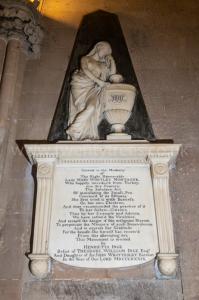
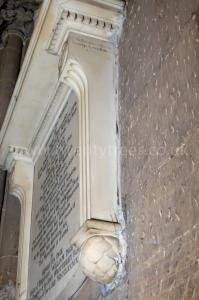
In 1808. Lichfield Cathedral [Map]. Monument to Andrew Newton. Sculpted by Richard Westmacott (age 32).
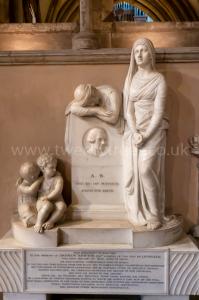
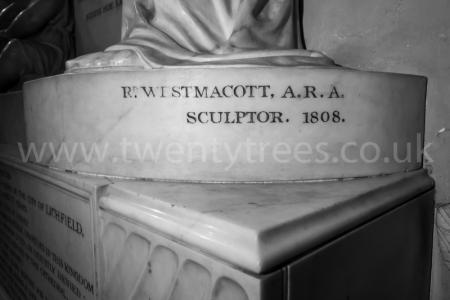
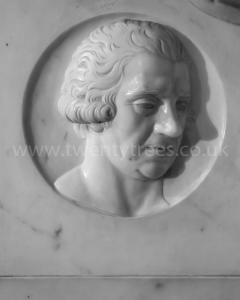
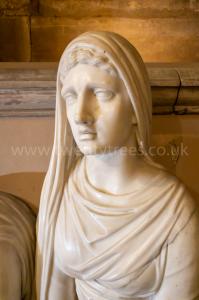
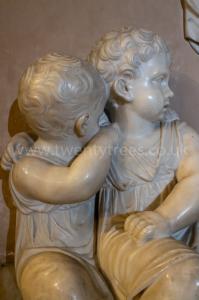
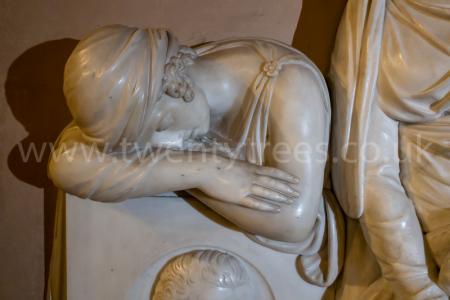
Memorials of Francis Chantrey RA in Hallamshire and Elsewhere Part V London Life and Works. In 1812, Chantrey (age 30) exhibited busts of Johnes of Hafod, of Curran, of Stothard, and of Northcote. In 1813, a bust of Cline, for the Royal College of Surgeons, and six others, including Granville Sharp. In 1814, busts of the King, of Professor Playfair, and a colossal head of the Duke of Wellington. In 1815, a bust of James Watt. In 1816, busts of the Marquis of Anglesey, Sir Everard Home, and Sir Joseph Banks. In 1817, (then newly made an associate of the Royal Academy,) "The Sleeping Children, "(the monument now in Lichfield Cathedral [Map],) and busts of Nollekens (age 74), Sir James Clarke, Bone the enamelist, Bird the painter, and Hookham Frere.
On 13 Mar 1812 Henry Bayly-Paget 1st Earl Uxbridge (age 67) died. He was buried at Lichfield Cathedral [Map]. His son Henry William Paget 1st Marquess Anglesey (age 43) succeeded 2nd Earl Uxbridge, 4th Baronet Bayly of Plas Newydd in Anglesey.
Memorials of Francis Chantrey RA in Hallamshire and Elsewhere Part V London Life and Works. Montgomery, whose opinions I quote the more freely, not merely because he has himself looked upon sculpture with a poet's eye, but also because he oft endeavoured to excite a similar taste in his gifted friend-says, "Nothing in sculpture is truly excellent but that which is pre-eminently so, because nothing less than the most successful strokes of the happiest chisel can powerfully affect the spectator, fix him in dumb astonishment, touch his heart strings with tender emotion, stir thought from its depths into ardent and earnest exercise. I appeal to all who hear me, whether, among a hundred of the monuments in our cathedrals, and the statues in our public places, they ever met with more than one or two that laid hold of their imagination, so as to haunt it both in retirement and in society? "Such are the Apollo Belvidere, the Venus de Medici, and other inestimable relics of antiquity; such the Moses and David of Michael Angelo; and such- ( to give an English example worthy to be named with these, judging solely by the power which it exercises over the purest and most universal of human sympathies, -- sympathies which can no more be bribed by artifice than they can help yielding to the impulse of nature ) -such, I say, is the simple memorial by our own Chantrey (age 35), in Lichfield Cathedral [Map], of two children that were 'lovely in their lives, and in death are undivided. Of these specimens, it may be affirmed, that they have shown how the narrow bonds of vulgar precedent may be left as far behind as a star in the heavens leaves a meteor in the air."1 There is not, indeed, a more exquisite group in the whole range of modern sculpture than Chantrey's "Two Children" in marble. The sisters lie asleep in each others arms in the most unconstrained and graceful repose. The snowdrops which the youngest had plucked are undropped from her hand, and both are images of artless beauty, and innocent and unaffected race. Such was the press to see these children in the London Exhibition, that there was no getting near them: mothers, with tears in their eyes, lingered, and went away, and returned; while Canova's (age 59) now far-famed figures of Hebe and Terpsichore stood almost unnoticed by their side. Chantrey modelled two other figures of this class, viz., a "Sleeping Child," the daughter of Sir Thos. Dyke Acland; and a "Reposing Infant," for Mr. Boswell, of Auchinleck.
Note 1. "Lectures on Poetry," p. 20.
1817. Lichfield Cathedral [Map]. Monument known as Sleeping Children. Sculpted by Francis Leggatt Chantrey (age 35). The sculpture represents two sisters Ellen-Jane and Marianne Robinson. The elder daughter Ellen-Jane died from burns after her nightdress caught fire. The younger Marianne died from illness the following year.
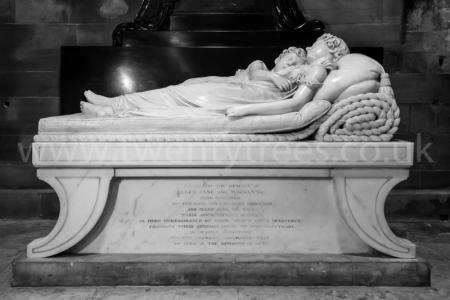
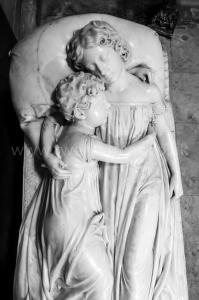
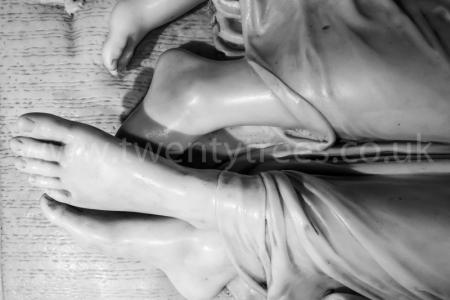
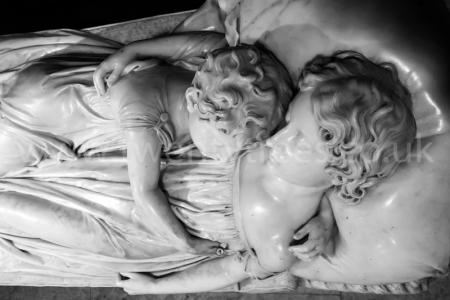
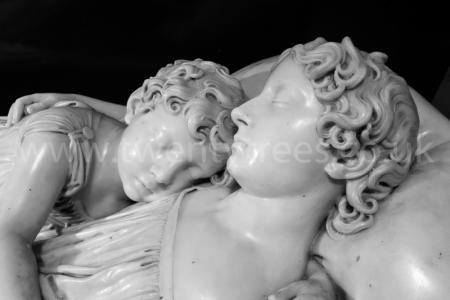
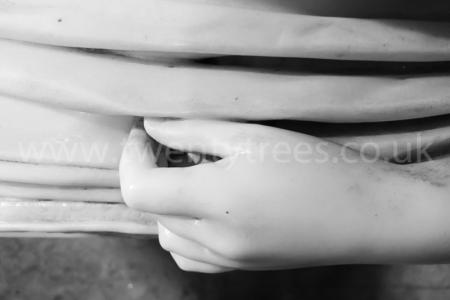
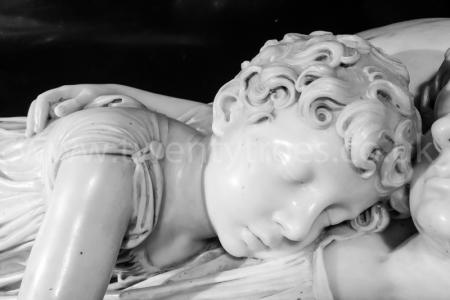
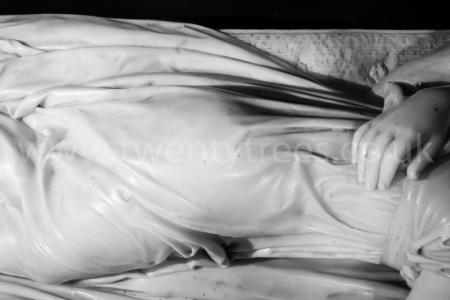
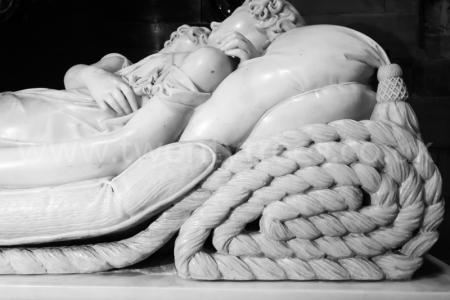
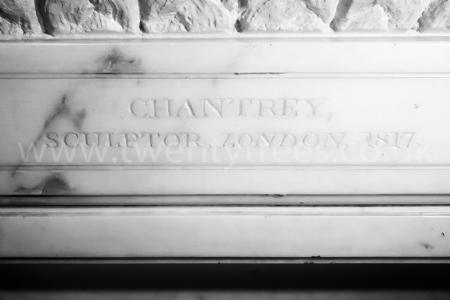
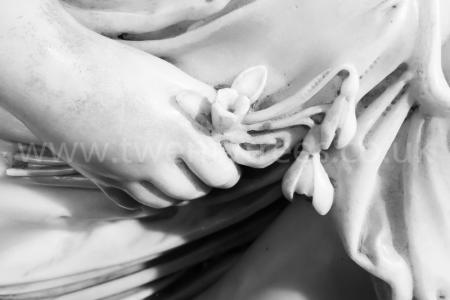
In 1824 Bishop Henry Dudley Ryder (age 46) was appointed Bishop of Lichfield.
On 23 Jan 1840 Bishop James Bowstead (age 39) was translated to Bishop of Lichfield.
Before 1841. Lichfield Cathedral [Map]. General monuments the middle of which sculpted by Francis Leggatt Chantrey (age 59).
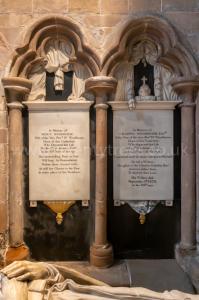
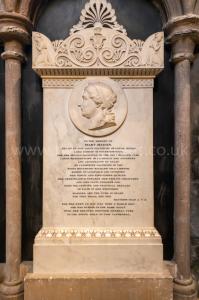
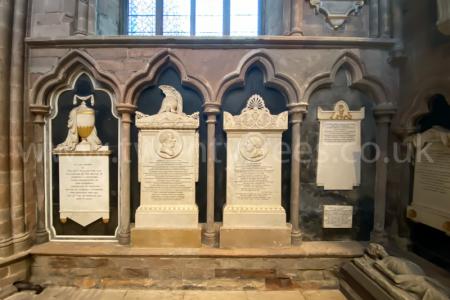
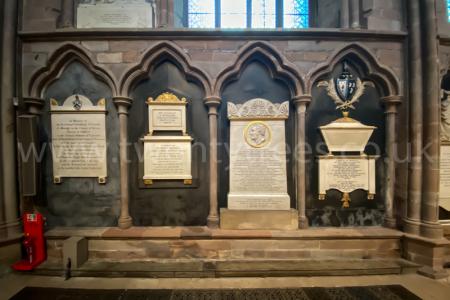
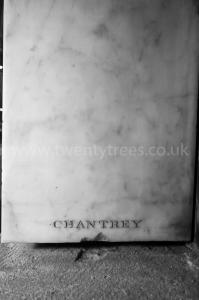
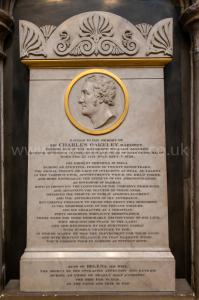
In 1841. Lichfield Cathedral [Map]. Sculpted by Francis Leggatt Chantrey (age 59).
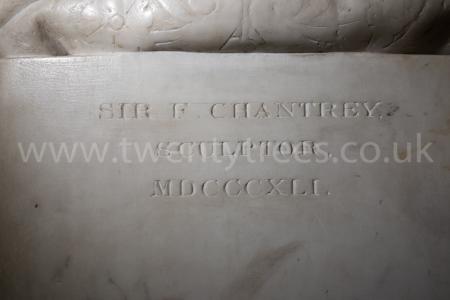
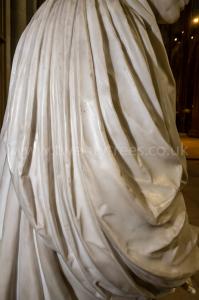
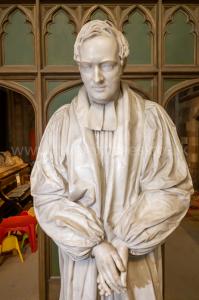
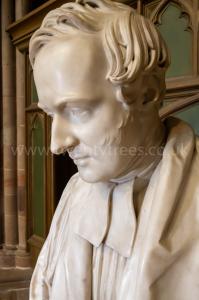
In Oct 1843 Bishop John Lonsdale (age 55) was elected Bishop of Lichfield.
On 03 Dec 1843 Bishop John Lonsdale (age 55) was consecrated Bishop of Lichfield.
On 13 Nov 1866 Admiral William Parker 1st Baronet (age 84) died. Monument in Lichfield Cathedral [Map]. His son William Parker 2nd Baronet (age 42) succeeded 2nd Baronet Parker of Shenstone.
William Parker 2nd Baronet:
On 14 Aug 1824 he was born to Admiral William Parker 1st Baronet and Frances Anne Biddulph. On 06 Jun 1885 William Parker 2nd Baronet and Jane Constance Biddulph were married. They were first cousins.
On 06 Jun 1885 William Parker 2nd Baronet and Jane Constance Biddulph were married. They were first cousins. On 23 Jan 1902 William Parker 2nd Baronet died. His son William Lorenzo Parker 3rd Baronet succeeded 3rd Baronet Parker of Shenstone.
On 23 Jan 1902 William Parker 2nd Baronet died. His son William Lorenzo Parker 3rd Baronet succeeded 3rd Baronet Parker of Shenstone.
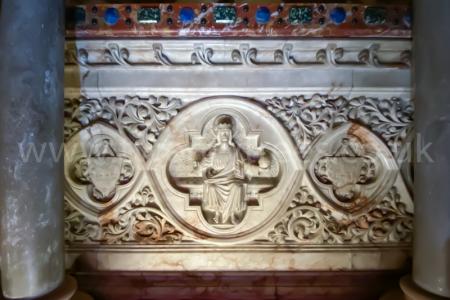
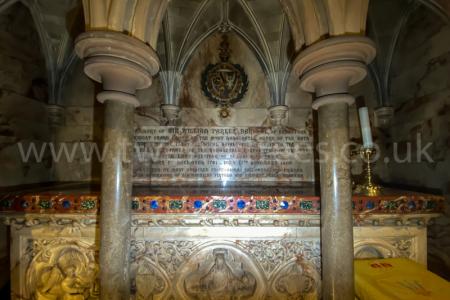
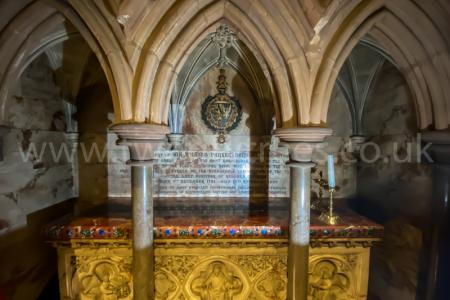
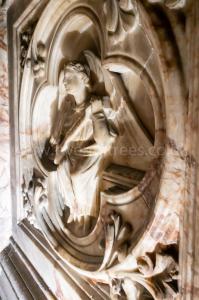
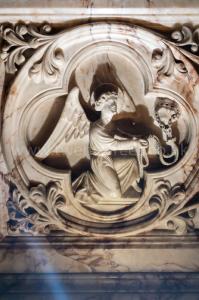
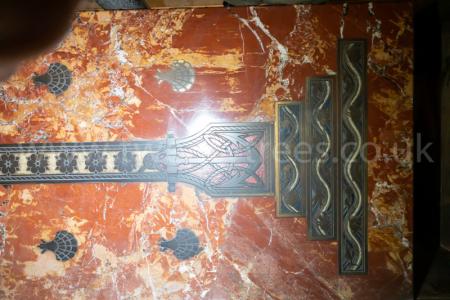
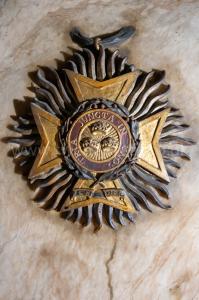
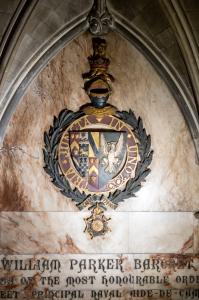
In 1872. Lichfield Cathedral [Map]. Monument to Henry Edward John Howard. Sculpted by Henry Hugh (age 43).
Henry Edward John Howard:
On 14 Dec 1795 he was born to Frederick Howard 5th Earl Carlisle and Margaret Caroline Leveson-Gower Countess Carlisle at Castle Howard. In 1805 Henry Edward John Howard educated at Eton College.
On 23 May 1814 Henry Edward John Howard was educated at Christ Church College, Oxford University.
On 08 Oct 1868 Henry Edward John Howard died.
In 1805 Henry Edward John Howard educated at Eton College.
On 23 May 1814 Henry Edward John Howard was educated at Christ Church College, Oxford University.
On 08 Oct 1868 Henry Edward John Howard died.
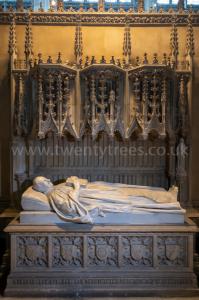
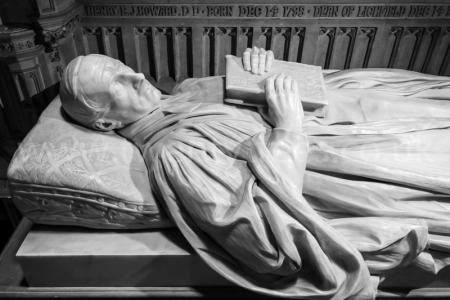
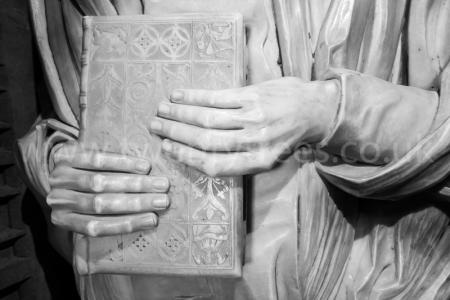
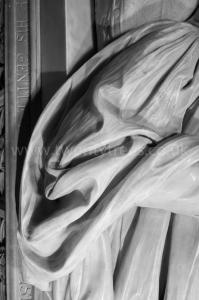
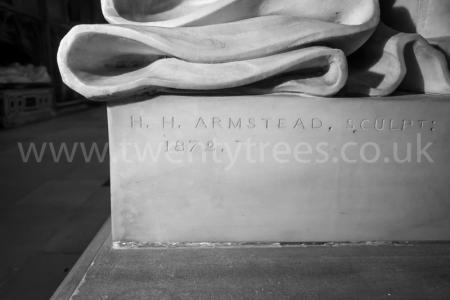
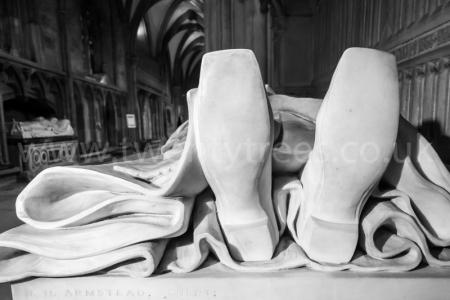
In 1875 Dean Herbert Mortimer Luckock (age 41) was appointed Dean of Lichfield.
On 17 Nov 1877 Captain Augustus Henry Archibald Anson VC (age 42) died in Cannes where he was buried. Monument in Lichfield Cathedral [Map].
Captain Augustus Henry Archibald Anson VC: On 05 Mar 1835 he was born to Thomas William Anson 1st Earl Lichfield and Louisa Barbara Catherine Phillips Countess Lichfield. On 16 Nov 1857 Captain Augustus Henry Archibald Anson VC was awarded Victoria Cross ... For conspicuous bravery at Bolundshahur, on the 28th September, 1857. The 9th Light Dragoons had charged through the town, and were reforming in the Serai; the enemy attempted to close the entrance by drawing their carts across it, so as to shut in the cavalry and form a cover from which to fire upon them. Captain Anson, taking a lance, dashed out of the gateway, and knocked the drivers off their carts. Owing to a wound in his left hand, received at Delhi, he could not stop his horse, and rode into the middle of the enemy, who fired a volley at him, one ball passing through his coat. At Lucknow, at the assault of the Secundra Bagh, on 16th November, 1857, he entered with the storming party on the gates being burst open. He had his horse killed, and was himself slightly wounded. He has shown the greatest gallantry on every occasion, and has slain many enemies in fight. In 1859 Captain Augustus Henry Archibald Anson VC was elected MP Lichfield which seat he held until 1868.
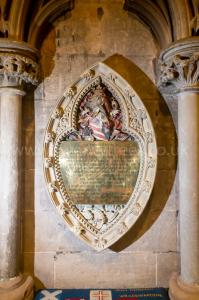
On 24 Jun 1878 Archbishop William Dalrymple Maclagan (age 52) was consecrated Bishop of Lichfield by Archbishop Campbell Tait at St Paul's Cathedral [Map].
In 1879. Lichfield Cathedral [Map]. Monument to Archdeacon Moore. Sculpted by Henry Hugh (age 50).
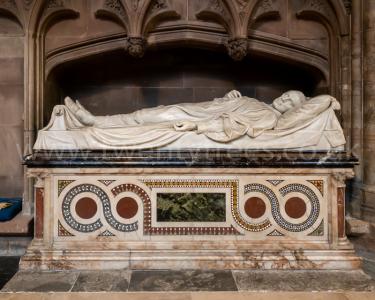
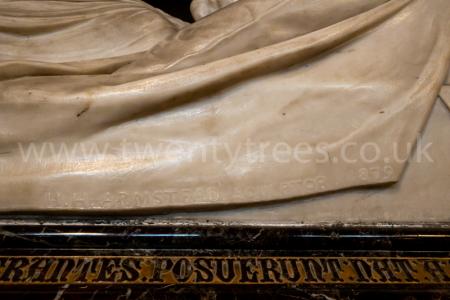
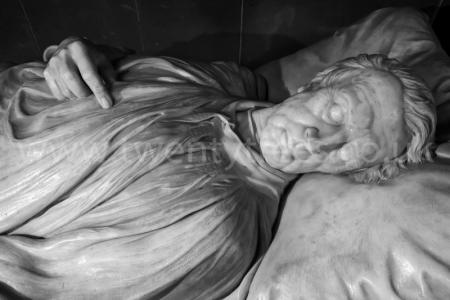
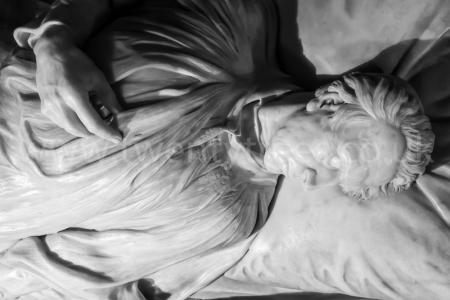
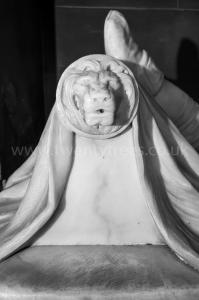
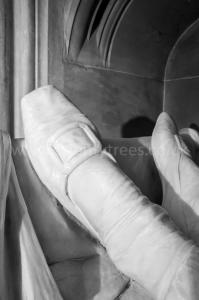
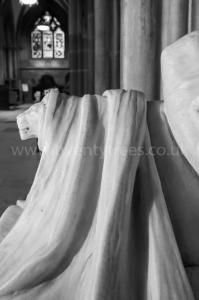
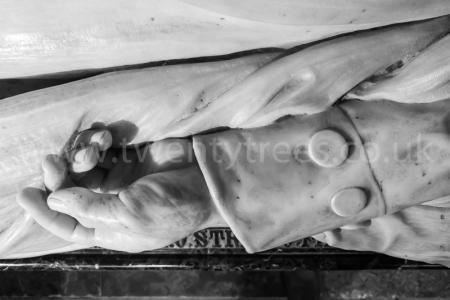
After 1888. Lichfield Cathedral [Map]. Monument to John Hodgson Iles Canon of Lichfield. Sculpted by Walter Rowlands Ingram (age 49).
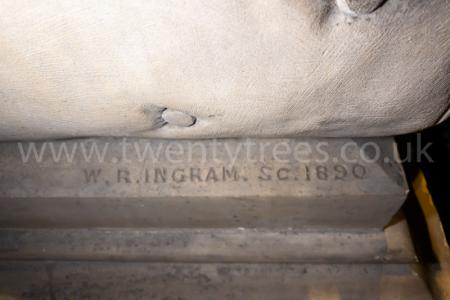
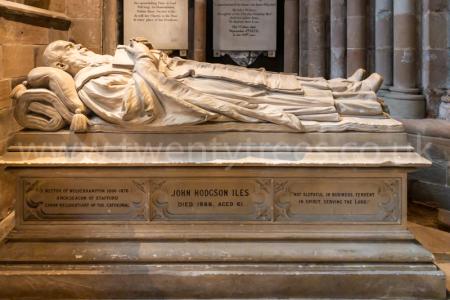
On 18 Jan 1890 Edward Henry Howard (age 57) died. Monument in Lichfield Cathedral [Map].
Edward Henry Howard: On 07 Jun 1832 he was born to Henry Edward John Howard.
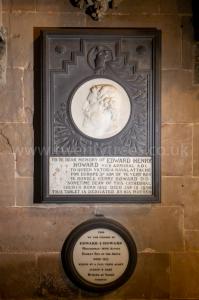
After 1907. Lichfield Cathedral [Map]. Monument to John Gylby Lonsdale Canon of Lichfield.
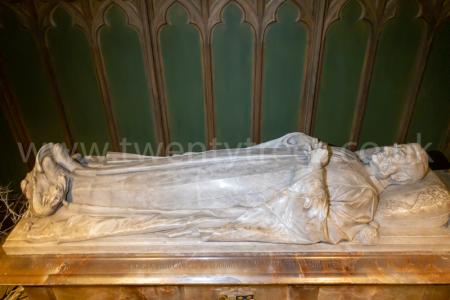

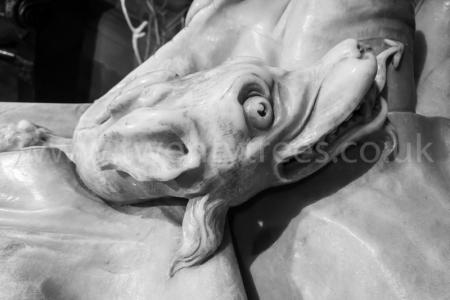
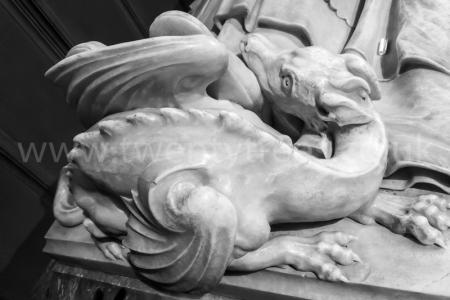
On 24 Mar 1909 Dean Herbert Mortimer Luckock (age 75) died. He was buried in the Cathedral Close at Lichfield Cathedral [Map].
Bede. HOW CEADDA, ABOVE-MENTIONED, WAS MADE BISHOP OF THE MERCIANS. OF HIS LIFE, DEATH, AND BURIAL.
At that time, the Mercians were governed by King Wulfhere, who, on the death of Jaruman, desired of Theodore to supply him and his people with a bishop; but Theodore would not obtain a new one for them, but requested of King Oswy that Ceadda might be their bishop. He then lived retired at his monastery, which is at Lestingau, Wilfrid filling the bishopric of York, and of all the Northumbrians, and likewise of the Picts, as far as the dominions of King Oswy extended. And, seeing that it was the custom of that most reverend prelate to go about the work of the Gospel to several places rather on foot than on horseback, Theodore commanded him to ride whenever he had a long journey to undertake, and finding him very unwilling to omit his former pious labour, he himself, with his hands, lifted him on the horse; for he thought him a holy man, and therefore obliged him to ride wherever lie had need to go. Ceadda having received the bishopric of the Mercians and Lindisfarne, took care to administer the same with great rectitude of life, according to the example of the ancients. King Wulfhere also gave him land of fifty families, to build a monastery, at the place called Barvc, or "The Wood," in the province of Lindsey, wherein marks of the regular life instituted by him continue to this day.
Bede. "In the name of our Lord God and Saviour Jesus Christ, who reigns for ever and for ever, and governs his church, it was thought meet that we should assemble, according to the custom of the venerable canons, to treat about the necessary affairs of the church. We met on the 24th day of September, the first indiction, at a place called Hertford, Hertfordshire [Map], myself, Theodore, the unworthy bishop of the see of Canterbury, appointed by the Apostolic See, our fellow-priest and most reverend brother, Bisi, bishop of the East Angles; also by his proxies, our brother and fellow-priest, Wilfrid, bishop of the nation of the Northumbrians, as also our brothers and fellow priests, Putta, bishop of the Kentish castle, called Rochester; Eleutherius, bishop of the West Saxons, and Winfrid, bishop of the province of the Mercians. When we were all met together, and were sat down in order, I said, ' I beseech you, most dear brothers, for the love and fear of our Redeemer, that we may all treat in common for our faith; to the end that whatsoever has been decreed and defined by the holy and revered fathers, may be inviolably observed by all.' This and much more I spoke tending to the preservation of the charity and unity of the church; and when I had ended my discourse, I asked every one of them in order, whether they consented to observe the things that had been formerly canonically decreed by the fathers ? To which all our fellow-priests answered, ' It so pleases us, and we will all most willingly observe with a cheerful mind whatever is laid down in the canons of the holy fathers.' I then produced the said book of canons, and publicly showed them ten chapters in the same, which I had marked in several places, because I knew them to be of the most importance to us, and entreated that they might be most particularly received by them all.